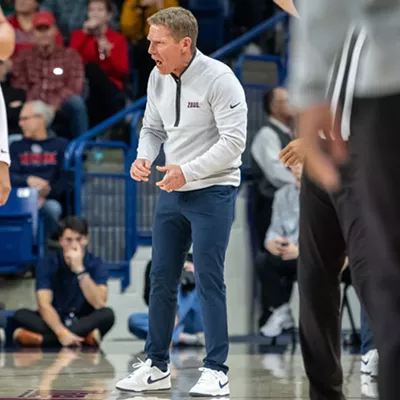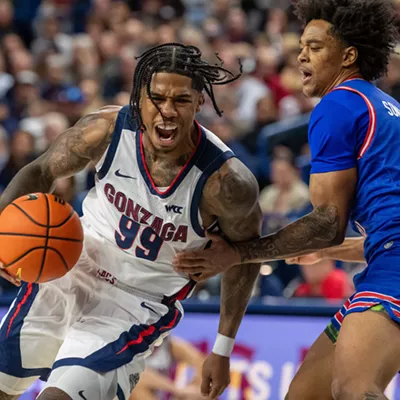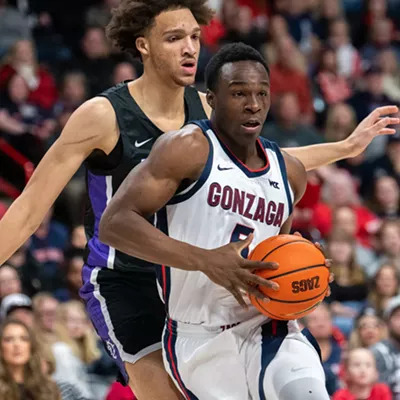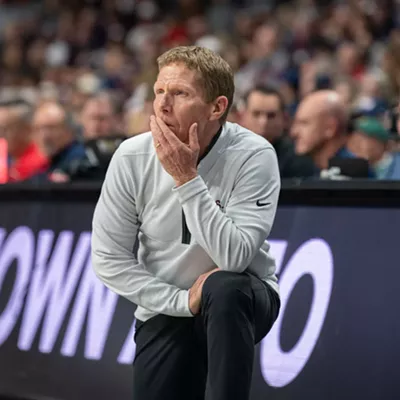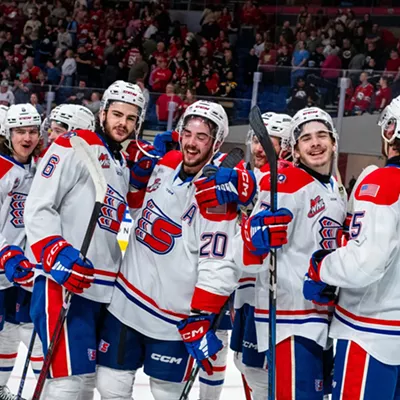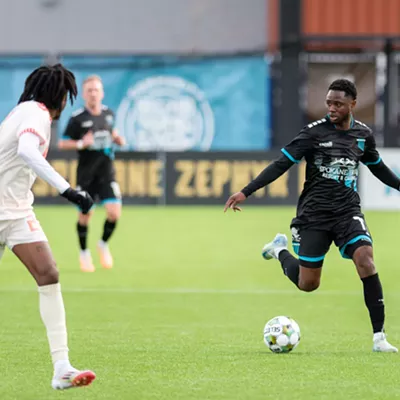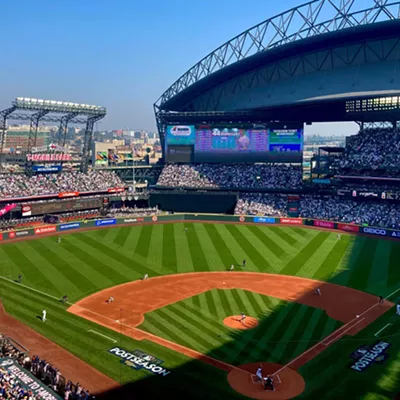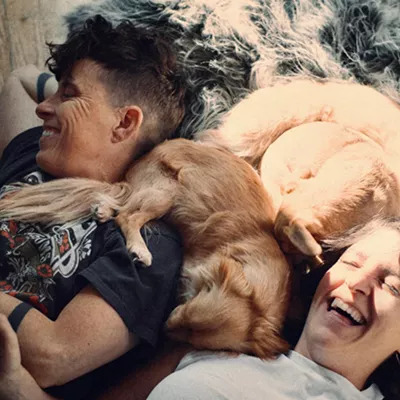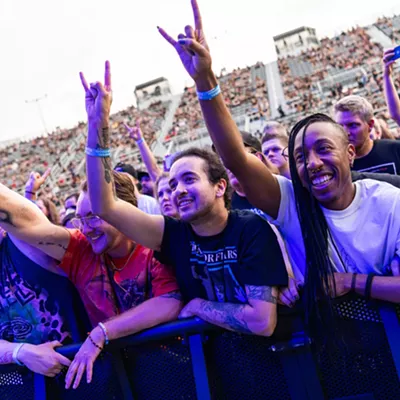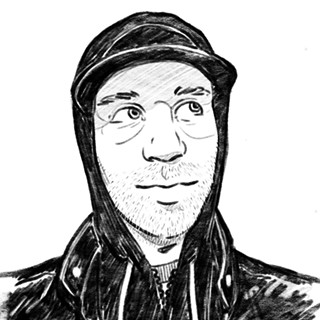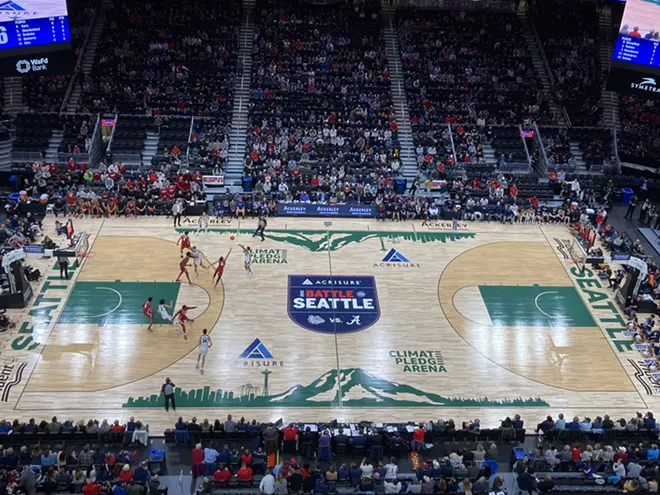
The Zags men's basketball team capped one of the squad's worst weeks in recent memory on Saturday by losing to Alabama 91-82 in front of a sold-out Climate Pledge Arena crowd in this year's edition of the Battle in Seattle. It capped a three-game stretch that also saw the Zags lose to Duke and sweat out a win to lowly Tarleton State.
There are many things that haven't gone the Zags way, but the one glaring flaw that some sharp-eyed observers (including me) feared might derail the season has proved to be true.
Flat out: This Gonzaga team can't shoot.
In recent years, there's been a three-point revolution across all levels of hoops, but the Zags seem to be lagging behind. The Bulldogs have now scored more than their opponents behind the arc in only three of their first nine games. The team currently ranks 172nd in the country in three-point makes per game, while shooting only 34 percent from deep (162nd in the country).
To be fair to Rasir Bolton and Julian Strawther, they've combined to mask the rest of the team's shooting deficiencies by shooting a respective 46.3 percent and 42.6 percent from three (a combined 39-88). The rest of the team? They've made 29 threes on 112 attempts. That's 25.9 percent. That. Is. Bad.
It's even been more ghastly in the team's two losses. Players not named Strawther and Bolton combined to shoot a robust ZERO PERCENT from three against Duke (0-7) and 30 percent against Alabama (3-10). Andrew Nembhard and Chet Holmgren combined to shoot a frightening 0-12 in those two contests with air balls aplenty. Holmgren's misses seem like the only explanation why he was benched down the stretch when the game was on the line in favor of Anton Watson, a move that makes no sense on the offensive or defensive end (especially when Nembhard never gets benched, even though he was far worse than Holmgren on both ends of the floor all game).
But it feels even worse than that when you're watching this team play. The fan confidence when the Zags pull up from deep has got to be near an all-time low in the Mark Few era. A number of times when attempting to come back on Saturday, the Zags had a chance for a momentum-swinging three that would've blown the (preserved) roof off Climate Pledge Arena only to lay brick after brick. Freshman Nolan Hickman gave a spark off the bench when he hit two threes in quick succession midway through the second half, but the momentum didn't hold.
It was more stomach-churning because of how completely dominant the Crimson Tide were from deep in the first half, blitzing the Zags with a 10-23 performance. When placed against the Zags' 2-7 showing, it meant Bama outscored Gonzaga by 24 points in the first 20 minutes just from deep shots. The inability of the Bulldog defenders to stay on their guys was an inexplicable return to the type of "make them make threes to beat us" defense that was the fundamental flaw of Few's pre-2014 teams. To Few's credit, the team locked in on three-point defense in the second half, only giving up one three-pointer for the first 16 minutes of the second half... only for Bama to hit back-to-back threes to ice the game by turning a four-point lead into a 10-point lead in the blink of an eye.
Perhaps the even bigger shooting woes for the Zags on Saturday came from the free-throw line. The Zags were just 13-25 from the charity stripe, including four misses on the front end of a one-and-one. That's essentially 16 potential points squandered in a close game while shooting in front of friendly fans. That's simply unacceptable for a squad this talented.
Outside shooting was a major flaw in last year's nearly undefeated team, too — it just didn't rear its ugly head until Corey Kispert went ice cold in the NCAA Tournament (shooting just 28 percent from deep in the Zags' final three games). That squad ranked 146th in the country in three-point makes per game. For some reason, analysts kept saying Gonzaga was a good team from deep all last year despite that not really being the case.
Recent Zags squads have overcome their deficiencies from behind the arc with hyper-efficient play from inside the arc. But Nembhard simply doesn't look like he's going to be the lead point guard who can operate on the level of Jalen Suggs, Nigel Williams-Goss, or even Josh Perkins. Outside of his fluky performance against UCLA, he struggles greatly to control the pace of the game and make accurate passes that actually hit his teammates in the pocket where they can catch or attack. Since teams don't have to respect his shot, that's unlikely to change.
What's worse for the team right now is that Few seems totally unwilling to admit that Nembhard is causing more issues than he's solving. He's been by far the worst player on the floor for the Zags over this abysmal three-game stretch: 8-26 shooting (0-9 from three) with 12 turnovers. Few's response? Nembhard has played the most minutes of anyone on the team in all of those games. While the freshmen Hunter Sallis, Hickman and even Holmgren can get pulled for a mistake, Nembhard never gets pulled. It's maddening to watch as a fan.
But let's not end on a totally negative note. While it's easy to feel like the sky is falling as spoiled Zags fans, this team is going to be fine and there's room for growth.
On the freshman side, Holmgren has a better shooting pedigree than he's shown so far in the big games. Hopefully Sallis and Hickman can get some of Nembhard's overstuffed workload, allowing them to showcase their skills while probably getting a better performance from Nembhard because he's being asked to do less.
And Drew Timme remains a dominant force and National Player of the Year contender. I think my favorite thing about Timme is how good he is when he "sucks." Like you can't find a Gonzaga fan who'll say Timme played really well in the Duke or Alabama games, and Timme — being a harsh self-critic — would probably say he was flat-out bad and let the team down. But then you look at the box score, and he averaged 20 points over those two games while shooting 53.1 percent from the field. When everyone agrees you're underperforming with stats like that, you're really $#&%*#@ good. (My take is that this disconnect between the perception and the reality comes about because plays when Timme gets overwhelmed by size stick in viewers' brains much more than the slew of almost routine plays where he gets a bucket due to extremely nifty post footwork.)
And heck, from a team perspective, we can all agree that Gonzaga played like trash against Duke and Alabama and one was a loss by three and the other was a four-point game with under four minutes left. Even when they're awful, this Zags squad can hang with Top 10 teams. (And the pollsters seem to agree, somewhat inexplicably only dropping GU two spots to No. 5 in both the AP and Coaches polls, ahead of both Bama and Tommy Lloyd's undefeated Arizona squad.)
But if the Zags want to turn things around before West Coast Conference plays, the team needs to stop shooting itself in the foot.
Actually, scratch that. They'd probably miss their own foot at this rate.
Drew Timme, physically embodying how that Gonzaga game felt. pic.twitter.com/YrdNgJ7MER
— Seth Sommerfeld (@sethsommerfeld) December 5, 2021



